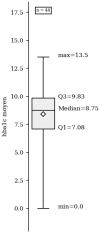Parental Low Level of Education and Single-Parent Families as Predictors of Poor Control of Type 1 Diabetes in Children Followed in French Guiana
- PMID: 40724118
- PMCID: PMC12294541
- DOI: 10.3390/ijerph22071051
Parental Low Level of Education and Single-Parent Families as Predictors of Poor Control of Type 1 Diabetes in Children Followed in French Guiana
Abstract
This study aimed to determine the prevalence of type 1 diabetes mellitus (T1DM) in French Guiana and describe the social profiles of the patients. We conducted a multicenter cross-sectional study of children under 18 years who were diagnosed with type 1 diabetes and followed up from 2002 to 2021. Over a 20-year period, 48 children under 18 years with type 1 diabetes living in French Guiana were included in the study, out of a total of 59 cases. There were 26 girls and 22 boys. The median age at diagnosis was 8.52 years [IQR 6-12]. The incidence rate was 5.9 per 100,000 people in children aged 0-18 years. The 5-9-year age group was the most affected 43.7% (95% CI 38-51%). Of these children, 56.2% (95% confidence interval 40-70%) lived in single-parent households, and 35% (95% CI 23-57%) of the parents had a primary education. Of the children, 29% (95% CI 21-42%) were from families with no resources. Diabetes was diagnosed by ketoacidosis in 56% (95% CI 38-74%) of the patients. Forty percent (95% CI 35-66%) of the patients had an HbA1c > 9%. There was an imbalance in the prevalence of children with higher Hba1c (>9%), with 18.7% (95% CI 10-29%, p < 0.001) of children whose parents had a low level of education having an Hba1c > 9% compared with only 6% (95% CI 3-10%) of children whose parents had a university degree, and a marked imbalance in the prevalence of children with High Hba1c (>9%) among children from single-parent families (22.9%, 95% CI 17-30%) compared with children whose parents lived in couples (8%, 95% CI 5-12%). The 10-14-year age group (18.7%, 95% CI 11-25%) had the highest imbalance in the prevalence of poor diabetes control between children whose parents had lower versus higher education levels. Diabetic retinopathy and diabetic nephropathy were the only reported complications. The multivariate analysis showed that a low level of parental education (Odds ratio 2.9 [95% CI 2.1-4.5], p < 0.001) and single-parent families (Odds ratio 3.1 [95% CI 2.6-4.3], p < 0.001) were predictors of poor control of T1DM. However, the lack of social insurance coverage at diagnosis was not associated with poor T1DM control (p = 0.4). In conclusion, these sociodemographic factors should be considered when caring for children with T1DM in French Guiana.
Keywords: French Guiana; children; parental low level of education; predictors of poor control; single-parent families; type 1 diabetes.
Conflict of interest statement
The authors declare that this research was conducted in the absence of any commercial or financial relationships that could be construed as potential conflicts of interest.
Figures
Similar articles
-
Parent training interventions for Attention Deficit Hyperactivity Disorder (ADHD) in children aged 5 to 18 years.Cochrane Database Syst Rev. 2011 Dec 7;2011(12):CD003018. doi: 10.1002/14651858.CD003018.pub3. Cochrane Database Syst Rev. 2011. PMID: 22161373 Free PMC article.
-
Intensive glucose control versus conventional glucose control for type 1 diabetes mellitus.Cochrane Database Syst Rev. 2014 Feb 14;2014(2):CD009122. doi: 10.1002/14651858.CD009122.pub2. Cochrane Database Syst Rev. 2014. PMID: 24526393 Free PMC article.
-
Treatment of periodontal disease for glycaemic control in people with diabetes mellitus.Cochrane Database Syst Rev. 2015 Nov 6;2015(11):CD004714. doi: 10.1002/14651858.CD004714.pub3. Cochrane Database Syst Rev. 2015. Update in: Cochrane Database Syst Rev. 2022 Apr 14;4:CD004714. doi: 10.1002/14651858.CD004714.pub4. PMID: 26545069 Free PMC article. Updated.
-
The risks, benefits, and resource implications of different diets in gastrostomy-fed children: The YourTube mixed method study.Health Technol Assess. 2025 Jul;29(25):1-21. doi: 10.3310/RRREF7741. Health Technol Assess. 2025. PMID: 40620081 Free PMC article.
-
Face-to-face interventions for informing or educating parents about early childhood vaccination.Cochrane Database Syst Rev. 2018 May 8;5(5):CD010038. doi: 10.1002/14651858.CD010038.pub3. Cochrane Database Syst Rev. 2018. PMID: 29736980 Free PMC article.
References
-
- Subramanian S., Khan F., Hirsch I.B. New advances in type 1 diabetes. BMJ. 2024;384:e075681. doi: 10.1136/bmj-2023-075681. Erratum in: BMJ 2024, 385, q1224. https://doi.org/10.1136/bmj.q1224 . - DOI - PubMed
-
- Njuieyon F., Buende Eyenga R.S., Elenga N. Annales d’Endocrinologie. Volume 75. Elsevier Masson; Issy-les-Moulineaux, France: 2014. Incidence du diabète chez les enfants de moins de 15 ans en Guyane française: 2011–2013.374p. - DOI
-
- Erikson E.H. Childhood and Society. 2nd ed. Norton; New York, NY, USA: 1963.
Publication types
MeSH terms
LinkOut - more resources
Full Text Sources
Medical




